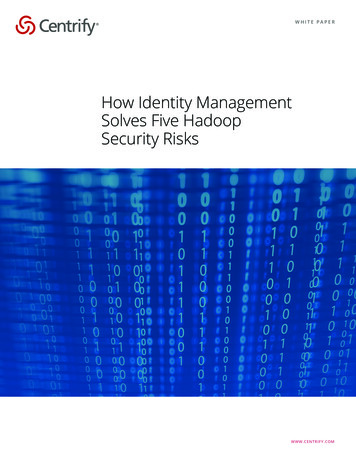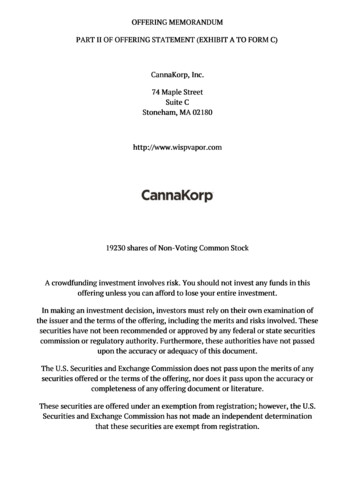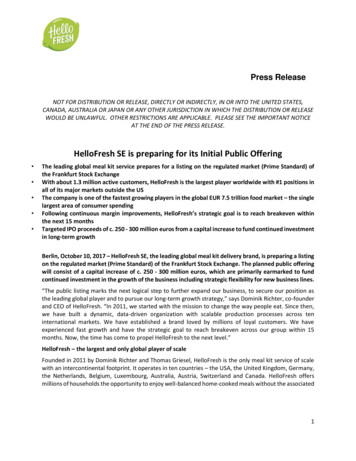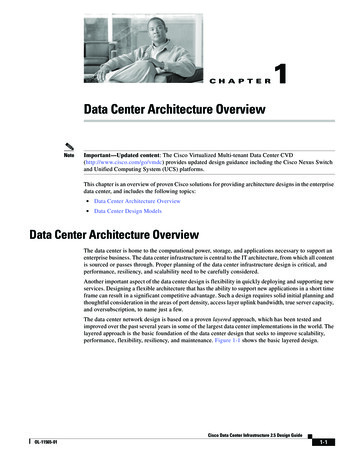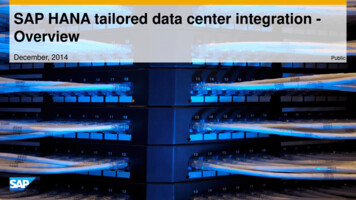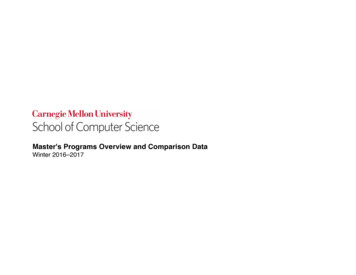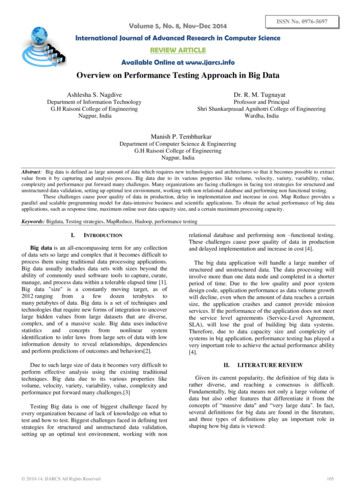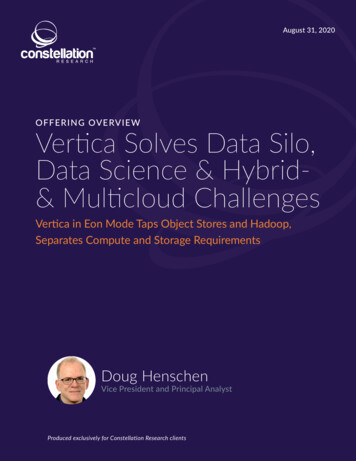
Transcription
.August 31, 2020OFFERING OVERVIEWVertica Solves Data Silo,Data Science & Hybrid& Multicloud ChallengesVertica in Eon Mode Taps Object Stores and Hadoop,Separates Compute and Storage RequirementsDoug HenschenVice President and Principal AnalystProduced exclusively for Constellation Research clients
TABLE OF CONTENTSExecutive Summary . . . . . . . . . . . . . . . . . . . . . . . . . . . . . . . . . . . . . . . . . . . . . . . . . . . . . . . . . . . . . . . . . . . . . . .3Company Overview . . . . . . . . . . . . . . . . . . . . . . . . . . . . . . . . . . . . . . . . . . . . . . . . . . . . . . . . . . . . . . . . . . . . . . .4About Vertica . . . . . . . . . . . . . . . . . . . . . . . . . . . . . . . . . . . . . . . . . . . . . . . . . . . . . . . . . . . . . . . . . . . . . . . . . . . .5Functional Capabilities . . . . . . . . . . . . . . . . . . . . . . . . . . . . . . . . . . . . . . . . . . . . . . . . . . . . . . . . . . . . . . . . . . . . .9Use Cases . . . . . . . . . . . . . . . . . . . . . . . . . . . . . . . . . . . . . . . . . . . . . . . . . . . . . . . . . . . . . . . . . . . . . . . . . . . . . 14Pricing . . . . . . . . . . . . . . . . . . . . . . . . . . . . . . . . . . . . . . . . . . . . . . . . . . . . . . . . . . . . . . . . . . . . . . . . . . . . . . . . 20Analysis and Observations . . . . . . . . . . . . . . . . . . . . . . . . . . . . . . . . . . . . . . . . . . . . . . . . . . . . . . . . . . . . . . . 20Recommendations . . . . . . . . . . . . . . . . . . . . . . . . . . . . . . . . . . . . . . . . . . . . . . . . . . . . . . . . . . . . . . . . . . . . . . 23Analyst Bio . . . . . . . . . . . . . . . . . . . . . . . . . . . . . . . . . . . . . . . . . . . . . . . . . . . . . . . . . . . . . . . . . . . . . . . . . . . . . 25About Constellation Research . . . . . . . . . . . . . . . . . . . . . . . . . . . . . . . . . . . . . . . . . . . . . . . . . . . . . . . . . . . . 26 2020 Constellation Research, Inc . All rights reserved .
E XECUTIVE SUMMARYVertica is a leading analytical data platform, and it’s among the most important products in theportfolio of Micro Focus International, Plc ., a multibillion-dollar, U .K .-based global software company .Vertica was founded in 2005 and introduced in 2007 as a columnar, scale-out analytical databasecapable of powering ultra-high-scale analytics . It has since evolved to be more than a database . Today,Vertica is a modern analytical data platform that can unify myriad data sources in warehouse- anddata-lake-style approaches; span SQL, multidimensional and data science analytical requirements; andadapt to on-premises, multicloud and hybrid deployment needs with flexibility and agility .This Offering Overview provides an overview of Vertica, which is one of two top research anddevelopment investment priorities for Micro Focus . This report identifies key differentiators,examines functional capabilities, considers Vertica’s strengths and weaknesses, and provides usecases, including three customer case studies . Technology buyers should use this report to evaluateVertica for implementation .Business ThemesData to DecisionsDigital Marketing &Sales EffectivenessNext-GenerationCustomer Experience 2020 Constellation Research, Inc . All rights reserved .TechnologyOptimization3
COMPAN Y OVERVIE WMicro Focus is a global software and software consultancy firmheadquartered in Newbury, Berkshire, England . The companywas founded in 1976, and its earliest success was in bringingthe COBOL language, so closely associated with mainframes,to microcomputers . Since going public in 2005, Micro Focushas been highly acquisitive, purchasing multiple softwareproduct lines and more than seven companies . Notableacquisitions include NetManage, Borland, Attachmate andSerena Software . Vertica joined the Micro Focus portfolioMicro FocusInternational, Plc.· Company: Micro FocusInternational, Plc· Headquarters: Newbury, England· Founded: 1976· Type: Public (MCRO on LondonStock Exchange and MFGP onNew York Stock Exchange)· 2019 Revenue: 3 .3 billion· No. of Employees: 12,000· Website: MicroFocus .com· Twitter: @MicroFocusthrough Micro Focus’s 2017 merger with the software businessunit of Hewlett Packard Enterprise .Today, Micro Focus has organized and focused its portfolio around four pillars ofdigital transformation: Insights, through analytical capabilities led by Vertica and focused on customerbehavior, Internet of Things initiatives, operational insight, and cognitive search andknowledge discovery capabilities delivered by the IDOL platform . Security, risk and governance, through breach defense, application security, dataprivacy, data governance and regulatory compliance products, such as ArcSight andInterset . Speed, through enterprise DevOps release orchestration and automated deliverytechnologies, such as Micro Focus LoadRunner Cloud . Agility, through hybrid (in the cloud and on-premises) IT service managementproducts, such as Micro Focus Operations Bridge . 2020 Constellation Research, Inc . All rights reserved .4
In February 2020, Micro Focus identified the security and insights pillars as the biggest drivers ofgrowth for the company . To underscore this priority, the company’s CEO announced that Micro Focuswill make incremental investments of 70 million to 80 million in Vertica and the security portfolio in2020, with additional investments planned for 2021 and beyond .This investment plan, which will be split approximately two-thirds toward research and developmentand one third toward go-to-market enhancements, underscores the importance of Vertica, the subjectof this report, as one of the cornerstones (if not the crown jewel) of the Micro Focus portfolio .ABOUT VERTIC AOverviewVertica was first released in 2007, at the dawn of the big data era, co-founded by renowned databaseinnovator Michael Stonebraker . The database was designed to manage vast data volumes, scaling intothe petabytes, while harnessing massively parallel processing and columnar architecture to ensurelightning-fast query performance .Today, Vertica is much more than a database . Vertica, which operates as an independent businessunit of Micro Focus, describes it as a “Unified Analytics Warehouse” because the delivery of analyticsmatters more than the location of the data sources or the style of the deployment . Vertica can powerfocused data marts or broader data warehouses, and it can draw on Hadoop or modern object-storebased data lakes . It spans conventional business intelligence (BI) and analytical requirements, whilealso powering built-in and externally developed machine learning (ML) algorithms . Vertica can bedeployed on-premises, on any public cloud (with quick-to-deploy marketplace options on the leadingplatforms) or in hybrid-cloud and multicloud combinations .To meet all these needs, Vertica has steadily evolved and matured over the last 15 years . The productwas first adapted to work in conjunction with high-scale, Hadoop-based data lake deployments,adding features to load data from Hadoop, work with the leading Hadoop file formats and directlyquery data in the Hadoop Distributed File System (HDFS) . 2020 Constellation Research, Inc . All rights reserved .5
Over the last five years, capabilities have been added to Vertica to better support data scienceworkloads and cloud deployment . Data science innovations include geospatial, time series and MLanalysis, flexible tables for schema-on-read flexibility, flattened tables supporting complex joins andmore extensive in-database support for ML algorithms .Cloud-oriented enhancements include ready-to-deploy images on leading cloud marketplaces andprebuilt integrations with native services on Amazon Web Services (AWS), Microsoft Azure (Azure)and Google Cloud Platform (GCP) . Also added were connectors for Amazon S3 and other cloud andon-premises object storage options . Most significantly, a new deployment option called Eon Modewas introduced to separate compute and storage decisions, promising cost savings and elasticity inhybrid-cloud and multicloud deployments .The Vertica 10 release in early 2020 introduced yet more Eon Mode deployment options along withdeep integration with Python and TensorFlow and new model import/export capabilities based on thePredictive Model Markup Language (PMML) .In short, the Vertica team has steadily evolved the product to keep pace with the demands oforganizations that seek to do the following: Unify diverse data sources and data types, at scales ranging from tens of terabytes tothe double-digit petabyte league . Meet diverse analytical requirements spanning business intelligence, advancedanalytics and machine learning . Unify deployments with flexibility and elasticity across hybrid environments, withoptions to run on bare metal and multiple public clouds .Market SegmentVertica is a high-scale analytical data platform, a segment of the larger database market that hasflourished and evolved over the last two decades . This segment was a tiny niche before exploding 2020 Constellation Research, Inc . All rights reserved .6
in the 2000s as organizations increasingly grappled with rising volumes and varieties of data on onehand and expectations for ever-faster analysis on the other .Data scale expectations quickly expanded in the 2000s as organizations looked beyond historicalinformation held in internal transaction systems, such as enterprise resource planning and customerrelationship management systems . Internet clickstreams, sensor data, log files, mobile data rich withgeospatial information and social network data were among the many forms of information thatpushed stores into the big data league above 10 terabytes . “Cloud-native” companies were alsoemerging, building entirely new data-driven business models by tapping into clickstreams and othercustomer behavior data at cloud-scale .At the dawn of the big data era, the leading general-purpose relational database management systems(RDBMS) at the time—Oracle Database, Microsoft SQL Server and IBM Db2—were being used fordata warehousing, but they had yet to be highly adapted for high-scale analytical use . As a result, datawarehouses and even focused data marts could not easily or affordably scale up to crunch tens orhundreds of terabytes, let alone petabyte-scale data .Early pioneers of the analytical database market harnessed massively parallel processing (used byTeradata) and column-store architectures optimized for analytics (used by Sybase IQ) . Also known asscale-out architecture, massively parallel processing (MPP) distributes workloads across many nodesfor scaling . MPP became the cornerstone of many high-scale, distributed data platforms, includinghigh-scale analytical databases, Apache Hadoop, Apache Spark and many NoSQL databases .Column-store databases have an advantage when querying selected columns of data, for example theZIP codes, product SKU numbers or transaction dates that populate a database . Such a query couldyield analytics on what sold in which regions within the last month without the need to wade throughall the (irrelevant-to-the-query) data stored row by row in a traditional, transactional database—suchas customer names, address, account number and so on . Less data queried translates into fasterquery results .As shown in Figure 1, high-scale analytical requirements have evolved and continue to change .Growing demand for big data analysis brought a renaissance of new database products to the marketby the mid-2000s . Vertica was among the innovators, tapping both MPP and columnar architecture . 2020 Constellation Research, Inc . All rights reserved .7
Figure 1. Vertica’s Maturation Mirrors the Evolution of High-ScaleAnalytical DatabasesThe Evolution of High-Scale Analytical Databases: 2005–20252005–2010“Big data”demandsspur newMPP &columnardatabases2010–2015Hadoop gainstraction,spawns SQLon-Hadoopoptions2015–2020Data science& cloudneeds driveanalytical &cloud scalingfeatures2020–2025Cloudmaturation,modern datalakes driveyet moreinnovationSource: Constellation ResearchStarting in 2010 and gathering steam by 2012, organizations looking to exploit high-scale data weredrawn by the promise of low-cost storage in Hadoop . Deployments multiplied, but the complexity ofthis new platform limited access to data . Analytical databases (including Vertica) soon adapted (andyet more products emerged), with new SQL-on-Hadoop options bringing the familiarity of SQL-basedquerying to data lakes .Innovations in high-scale analytical databases continued over the last five years, with yet morefeatures introduced for in-database data science capabilities (as exemplified by Vertica’s builtin ML algorithms) and separation of compute and storage provisioning (pioneered by Snowflakeand implemented in Vertica through Eon Mode in 2018) . Market trends have favored cloud-readysoftware, but dedicated, hardware-based offerings are still available, including Oracle Exadata, variousTeradata hardware-based offerings and the IBM Netezza Performance Server .Throughout this evolutionary period, the market has seen ever-rising demands for scalability,query performance, user- and query-concurrency, and sophisticated analysis capabilities . Whilesome products have fallen by the wayside, the market leaders have remained vibrant by helpingorganizations to embrace a range of data sources and storage options, to support a broad rangeof analytical needs extending into data science and to meet a range of evolving deploymentrequirements, from conventional on-premises to public clouds and a changing, hybrid-cloud andmulticloud mix of choices . 2020 Constellation Research, Inc . All rights reserved .8
Partnerships and AlliancesVertica has strong, long-term partnerships on three fronts: technology partners, original equipmentmanufacturers (OEMs) and systems integrators . Following is a summary of these partnership typesalong with leading examples . Technology partners: Software and service providers across many categoriesintegrate with Vertica . Public cloud provider AWS, for example, is a long-term partner,and the AWS Marketplace offers both Vertica by the Hour, a usage-based offering,and ready-to-deploy Vertica BYOL (bring your own license) instances available onAmazon Linux or RedHat . (Vertica by the Hour was made available on GCP in August,and BYOL options are also available on GCP and Azure .)Other important technology partners include data integration vendors (includingInformatica, IBM, SAP, Talend and TIBCO) and BI and analytics vendors (including IBMCognos, Looker, MicroStrategy, Qlik, SAS and Tableau) . OEM partners: Dozens of OEM partners use Vertica as the analytical databaseunderpinning their software or services . Examples include CA Technologies,CallidusCloud, Cisco, FICO, NetScout, NICE and Vendavo . Systems integrator partners: These organizations help Vertica customers withsystems design and deployment consulting, offering specific knowledge of sourcesystems, Vertica performance and configuration . Leading examples include Deloitte,Hewlett Packard Enterprise, Tata Consultancy Services and Tech Mahindra .FUNC TIONAL C APABILITIE SVertica’s calling cards of vast scalability and superior query performance were designed-in at theproduct’s inception, thanks to the combination of MPP scalability and column-store query-speed andcompression advantages . Nonetheless, the database has been extended over the last 15 years tobecome a versatile analytics platform spanning data sources, analytical requirements, storage choicesand deployment choices . 2020 Constellation Research, Inc . All rights reserved .9
Detailed below are key categories of functionality that help organizations to unify data silos,span advanced analytical and data science needs, and meet hybrid- and multi-cloud deploymentrequirements . At the conclusion of each section are the latest upgrades introduced in early 2020 withthe release of Vertica 10 .Unify Data SilosVertica handles the analysis of conventional structured sources as well as sparse and variable datatypes common to Hadoop and NoSQL stores . Features include: Standard SQL Support (ANSI 99) . JSON and log file format support, Kafka read/write, and ORC and Parquet readers forquerying Hadoop and emerging object-storage-based data lake platforms . Parquet export for writing result sets back to external data lake platforms . Role- and column-based security for secure integration with source systems . Vertica 10 upgrades include:- Support for querying complex data types, such as Maps, Arrays and Structsstored in Parquet and common to S3, HDFS and Google cloud storage .- Security advances, which include improved LDAP link for user authentication,simplified Transport Layer Security (TLS) certificate administration andKerberos support for the open source Vertica Python interface .Unify Analytics & Data ScienceThe analytic requirements of leading organizations have extended well beyond standard SQL . Verticahas been steadily enhanced to support a broad range of business intelligence, advanced analytics anddata science requirements . Capabilities include: 2020 Constellation Research, Inc . All rights reserved .10
Advanced SQL functions including pattern matching, time series andgeospatial analysis . Relational online analytical processing (ROLAP) SQL functions supportingmultidimensional analysis include rollup aggregations, grouping sets aggregations,cube aggregations and pivot . Predictive analytics and ML functions include outlier detection, linear and logisticregression, k-means, Naïve Bayes, random forest and confusion matrix . Vertica UDx (user-defined extensions) framework enables parsers and data loaderswritten in C , Java, R and Python to be run in-database as Vertica SQL functions . Open source Python client and Python SDK for Vertica support the use of Jupyternotebooks and in-Vertica processing of user-defined functions expressed in Python . Vertica 10 upgrades include:- PMML model export support for training of models on Vertica using parallel,in-database algorithms and subsequent export of finished models to externalsystems for scoring .- PMML import supports training of models on a choice of external frameworksand languages (such as Apache Spark, R and Python) . Models exported fromthese tools in PMML format can be imported to Vertica, where they can bemanaged as easily as tables and run in production on very large datasets .- TensorFlow model import supports training of custom ML models (includingdeep neural network models) on a choice of compute platforms (including highperformance compute or GPU-based systems, as required) . Models saved inTensorFlow’s native graph format can be imported to Vertica and used fordistributed prediction on very large datasets . 2020 Constellation Research, Inc . All rights reserved .11
Unify Hybrid-Cloud and Multicloud DeploymentsCore management and administrative features and the Eon Mode option introduced in 2018 simplifythe deployment and use of Vertica in on-premises deployments, on multiple public clouds or in ahybrid mix of these options . Relevant Vertica features include the following: Database Designer automatically creates p
ABOUT VERTICA Overview Verica was irst released in 2007, at the dawn of the big data era, co-founded by renowned database innovator Michael Stonebraker. The database was designed to manage vast data volumes, scaling into the petabytes, while harnessing massively parallel processing and columnar architecture to ensure lightning-fast query .
